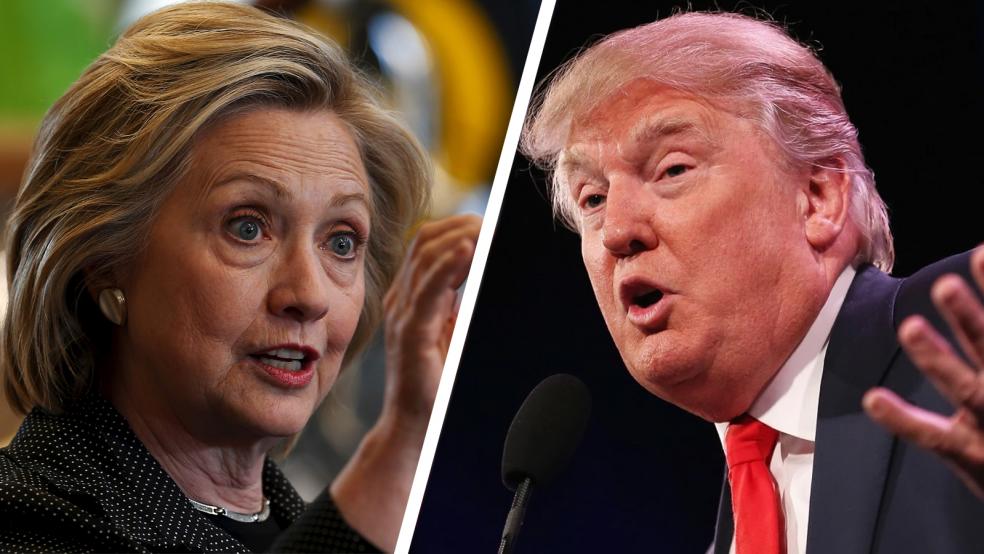As Hillary Clinton prepares to take another big step toward supporting liberal calls for universal health care coverage, a new study concludes that Donald Trump’s proposals for replacing Obamacare would strip nearly 18 million mostly low-income Americans of their current coverage.
The study by the non-partisan Center for Health and Economy provides the first detailed analysis of the presumptive GOP nominee’s scattershot proposals on health care. They include removing barriers to the sale of health insurance across state lines, expanding the use of health savings accounts to mitigate the cost of high-deductible insurance policies and allowing households to deduct premiums from their taxable income.
Related: Clinton Moves Toward Sanders on ‘Medicare for All’
Trump’s approach would likely reduce premiums for private health insurance coverage and cut the government’s operating and subsidy costs by $583 billion over the coming decade, according to the study. But under Trump’s proposals and the current budget baseline, there would be 18 million fewer people insured in 2017 than there are today — a situation that would improve only slightly by 2026 to 13 million fewer insured than under the current law.
Trump’s plan would have a negligible effect on the Medicare health program for the elderly or on individuals covered by employer-provided insurance. But it would have a devastating impact on millions of low-income Americans who qualified for expanded Medicaid coverage under Obamacare or who depend on government subsidies to purchase private insurance on the existing government-operated exchanges. About 7 million people in 31 states and the District of Columbia have benefitted from expanded Medicaid benefits for people with incomes below 138 percent of the federal poverty level.
Clinton is certain to lash out at Trump’s plan next week, when she is expected to unveil new proposals of her own that would move her even closer to Sen. Bernie Sanders’s call for a single-payer, Medicare-for-all approach that would eventually guarantee that every American gets covered.
Related: Get Ready for Huge Obamacare Premium Hikes in 2017
Health care coverage was a major point of contention between Clinton and Sanders during the hard-fought Democratic primary. Sanders promoted a European-style national health care program that would supersede Obamacare. Clinton, the former secretary of state and close ally of President Obama, opposed Sanders’s approach, saying that it would be ridiculous to replace the Affordable Care Act now when only little more than a tenth of Americans still are without coverage.
Clinton nonetheless spelled out a number of proposals to address the problems of rising health care premiums, out-of-pocket costs, prescription drug prices and out of network hospital charges.
Then in late May, she surprised many by suggesting during a campaign stop in Virginia that she would be open to allowing some people under the age of 65 to buy into Medicare, the premier federal health care plan for seniors. “I’m also in favor of what’s called the public option, so that people can buy into Medicare at a certain age,” Clinton said at the time.
Related: How Obamacare Could Backfire on Hillary Clinton
Since wrapping up the Democratic nomination in early June, Clinton has sought to woo Sanders and millions of his liberal supporters with a series of policy concessions, ranging from a $15 minimum wage and expanded Social Security benefits to breaking up banks deemed too big to fail and providing free in-state tuition at public colleges and universities to many students from low-income families.
Sanders will formally endorse Clinton for president next week, according to The Washington Post, and aides to the two campaigns have been in talks about a new compromise on health care more reflective of Sanders’ call for a Medicare-for-all program.
Regardless of what they finally agree to, it is certain to be a far cry from Trump’s approach, which the report says would turn back the clock on much of the progress that has been made over the past few years in lowering the uninsured rate for Americans. Only 11 percent of adults and children are still without health care coverage, according to a new survey by Gallup and Healthways released in April.
Trump would eliminate the government mandate on individuals to acquire insurance or pay a penalty. He would shutter the health insurance markets currently operated across the country by the federal government and states. And he would eliminate federal subsidies to help lower income people pay their premiums and out-of-pocket costs.
Related: Administration Officials Knew Obamacare Co-ops Were Failing in 2012
Trump’s campaign contends that his proposals would greatly enhance competition within the insurance industry, help to reduce costs for consumers and level the playing field for many Americans who aren’t covered by tax-exempt employer-provided insurance policies. Just as employers receive a tax break on health insurance plans offered to their employees, Americans who must purchase health coverage from insurers could now claim income tax deductions to help defray the cost of their insurance.
Trump has also embraced a long-standing congressional GOP plan to convert the Medicaid program for the poor to federal block grants to the states, to give governors and state legislatures the primary say in how to assist low-income adults and children. In many states controlled by Republicans, that would likely mean a reduction in eligibility and new premiums and charges.
The new study emphasizes that there is considerable uncertainty surrounding many of Trump’s proposals, making it difficult to accurately assess. The Center for Health and Economy researchers noted that they sought to present “an unbiased, middle-ground representation” of the effects of Trump’s plan.





